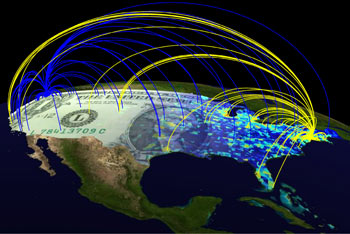Universal rules governing the way humans travel
Jan 26, 2006 - 5:52:00 AM, Reviewed by: Dr. Priya Saxena
|
|
Increasing human mobility is a key cause of the geographic spread of modern epidemics. Bacteria and viruses can be transported across great distances and transmitted to other people. In order to understand and predict the spread of disease, we need to know the statistical rules that govern human travel - in the light of an imminent flu pandemic a knowledge of great importance. Quantitative studies, however, prove to be very difficult, because people move over short and long distances, using various means of transportation (planes, trains, automobiles, etc.). Scientists from the Max Planck Institute for Dynamics and Self-Organization in G�ttingen, the University of G�ttingen, and the University of California, Santa Barbara, have found a trick to determine these rules. They had the idea of evaluating data from a popular US internet game in which participants can register a dollar bill for fun and monitor its geographic circulation. Like viruses, money is transported by people from place to place. Surprisingly, the scientist found that the human movements follow what are known as universal scaling laws. They developed a mathematical theory which describes the observed movements of travellers amazingly well over distances from just a few kilometres to a few thousand. The study represents a major breakthrough for the mathematical modelling of the spread of epidemics
|
By Max Planck Society,
The worldwide spread of disease - particularly, pandemics with disastrous consequences for human health and economics - has become a serious threat in the globalised world of intense international trade, growing mobility, and increasing traffic intensity. Bird flu (avian influenza A), the possible emergence of a new human "supervirus", and a potential worldwide flu pandemic, have all made headlines in the last weeks and months - for good reason.
The prime cause of the geographical spread of disease is the movement of infected individuals from place to place. Historical pandemics, like the 14th-century plague, only moved slowly in wave fronts across geographical areas, because in the middle ages people could typically only travel a few kilometres a day. The speed with which epidemics could spread was thus kept in check. The rapid worldwide spread of SARS (severe acute respiratory syndrome) has already demonstrated this.
In order to describe the spread of modern disease using mathematical models, and to develop a way of predicting that spread, we need a quantitative knowledge of people�s travelling behaviour at various scales of distance. Unfortunately, until now, one has not been able to quantify the characteristics of human travel. Over short to medium distances, people use bicycles, cars, and trains. Over longer ones, airplanes are typical. In order to obtain a comprehensive dataset on human travel, transportation flow would have to be measured, nationally and internationally, over a long period of time. D Brockmann, L Hufnagel, and T Geisel, theoretical physicists at the Max Planck Institute for Dynamics and Self-Organization in G�ttingen, the University of G�ttingen, and the University of California Santa Barbara, have now found an innovative way around these difficulties, and determined the rules governing human travel with a high precision.
Instead of the movements of individuals, the researchers investigated the geographical circulation of banknotes which travellers carry from place to place. The physicists analysed the data from a US bill-tracking internet game. If a person receives a marked banknote, he/she can register its current location online and return the bill to the pool. Dirk Brockmann of the Max Planck Institute for Dynamics and Self-Organization says, "we recognised that the enormous amount of data, as well as the geographical and temporal resolution of bill-tracking, allow us to draw conclusions about the statistical characteristics of human travel, independent of which means of transportation people use. This hope was borne out beyond expectations. In the data about movement, the scientists discovered universal scaling laws which lie at the root of human travel behaviour. Scientists are already familiar with similar scaling laws from physical and biological systems - for example, turbulent flow and chaotic systems. This result surprised us all.
 |
| The movement of banknotes in the United States. Each line symbolises the geographic movement of a single banknote between the place of origin (blue: Seattle, yellow: New York) and various destinations. Each banknote travelled for less than a week. Image: Max Planck Institute for Dynamics and Self-Organization |
Until now, numerous models of the geographic spread of disease were based on the assumption that viruses disperse over geographic areas in a way similar to the diffusion of fine dust particles on the surface of water. These standard models can describe the wavelike spread of historical pandemics quite successfully. Dirk Brockmann concludes that "the consequence of these results is that new theoretical concepts must be developed to understand the geographic spread of modern diseases.
Because the mechanisms of transmission of diseases from human to human are already well understood, the scientists can use the new theory to investigate new models which describe the global spread of disease much more realistically. Professor Theo Geisel, Director of the Max Planck Institute for Dynamics and Self-Organization, says that "we are optimistic that this will drastically improve predictions about the geographical spread of epidemics." 
- D Brockmann, L Hufnagel and T Geisel, The scaling laws of human travel, Nature, 26 January 2006
Project Website is at www.chaos.gwdg.de
For any corrections of factual information, to contact the editors or to send
any medical news or health news press releases, use
feedback form
Top of Page
|